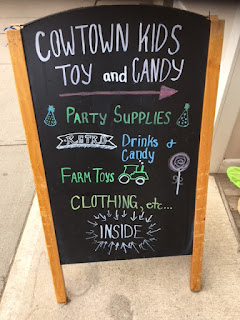 On the way home from Calgary, the
car pretended to self-drive for a few minutes, right into Maple Creek for
lunch. I can no longer
simply drive by this singular small town of just over two thousand people,
having savoured its hospitality and fantastic food in July. At that time, I did know that Maple Creek is the
Gateway to Cypress Hills and Fort Walsh. What I didn’t know was that it’s a travel destination
all on its own.
On the way home from Calgary, the
car pretended to self-drive for a few minutes, right into Maple Creek for
lunch. I can no longer
simply drive by this singular small town of just over two thousand people,
having savoured its hospitality and fantastic food in July. At that time, I did know that Maple Creek is the
Gateway to Cypress Hills and Fort Walsh. What I didn’t know was that it’s a travel destination
all on its own.
That iconic Saskatchewan July day, who knew
we would head into Maple Creek from our home base on the highway, the EagleValley Campground, loaded onto the flatbed of a tow truck! A two-week old starter started, but then
wouldn’t stop. That’s how it goes,
sometimes. The opportunity the misadventure disguised revealed itself about ten minutes later.
 |
| Chicken Noodle Soup and House Roll at The Shop |
My husband supervised the repairs in the
garage, and I scooted into The Shop
across the street just as the skies opened. In Chef Jordyn Winzer’s Bakery / Deli, I settled in to wait
out the storm and the breakdown with a cranberry-coconut cookie, a mug of coffee,
books and my computer. Not much time to read, though, as
another RV breakdown victim sought refuge in the restaurant. I can’t resist a French accent,
however, and seized the opportunity for a conversation in French with a visitor
from Quebec. Not five minutes
after his departure, a French-speaking family stopped by. They were motorcycling to the Rockies,
each parent with a teen behind them on the machine. By the end of that stimulating exchange, the skies had
cleared. A container of roasted garlic carrot humus
in hand, I headed to the garage to check in; just a few more minutes, and we’d
be rolling, a new starter installed.
 By then, supper was a logical next step,
and the Star Café and Grill beckoned.
Featured in the Globe and Mailin January, the restaurant was at the top of our personal gotta-eat-there
list. It didn’t disappoint. I had carmelized onion soup and lettuce
wraps. With Cypress Hills rhubarb wine,
the light and flavourful meal refreshed and satisfied. During our walk later, I made mental
notes to stop at Country Lane Kitchens and Cowtown Kids Toy and Candy before
our departure. I continue to
wonder how a town of approximately two thousand people can support a
kitchen store and a toy / book store?
My own town more than twice the size doesn’t!
By then, supper was a logical next step,
and the Star Café and Grill beckoned.
Featured in the Globe and Mailin January, the restaurant was at the top of our personal gotta-eat-there
list. It didn’t disappoint. I had carmelized onion soup and lettuce
wraps. With Cypress Hills rhubarb wine,
the light and flavourful meal refreshed and satisfied. During our walk later, I made mental
notes to stop at Country Lane Kitchens and Cowtown Kids Toy and Candy before
our departure. I continue to
wonder how a town of approximately two thousand people can support a
kitchen store and a toy / book store?
My own town more than twice the size doesn’t! The next day, after visits to both
businesses, I had even more questions.
Just a few steps into the store, I could tell that Country Lane Kitchens
rivals any similar enterprise in a city.
When I spied a display of Bosch kitchen machines, I asked about the
metal driver for the cookie paddles.
What? They had them on
hand? Really? I left with a driver and the cake
paddles too, for the price of the driver and shipping online. Country Lane Kitchens, too, would be
added to our Calgary itinerary.
The next day, after visits to both
businesses, I had even more questions.
Just a few steps into the store, I could tell that Country Lane Kitchens
rivals any similar enterprise in a city.
When I spied a display of Bosch kitchen machines, I asked about the
metal driver for the cookie paddles.
What? They had them on
hand? Really? I left with a driver and the cake
paddles too, for the price of the driver and shipping online. Country Lane Kitchens, too, would be
added to our Calgary itinerary.
The two story half-block toy store is a
child and grand-parent’s nirvana.
As I meandered from the
science experiments through the
games and the building toys, past the kites and the trucks, I wondered how I
could have been oblivious to this treasure for so long. No more. Cowtown
Kids Toy and Candy will be another regular stop.
To celebrate our memorable three days in
Maple Creek and Cypress Hills, we headed to the Rockin’ Horse Bar and
Grill. I didn’t want a heavy
meal. One of the chef’s specials
that night was a small lasagne and salad, with lots of sauce, the description added. So tempting! But I never order pasta in a restaurant. In the end, my
decision to trust the description paid off in a delightful small oval dish of
narrow lasagne noodles slathered in a robust marinara sauce, with a fresh salad
on the side. Another perfect meal
for me.
Thank you, Maple Creek, for a great three
days in July and an energizing short pit stop a few days ago. We’ve been extolling your hospitality and your treasures
since we got back, and we’ll alter our travel routine to assure a stop in your
special town.















